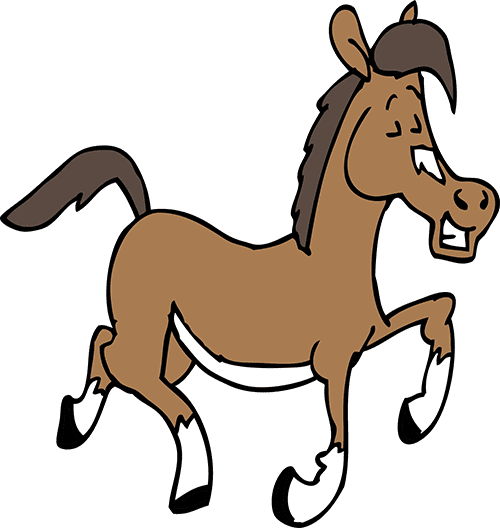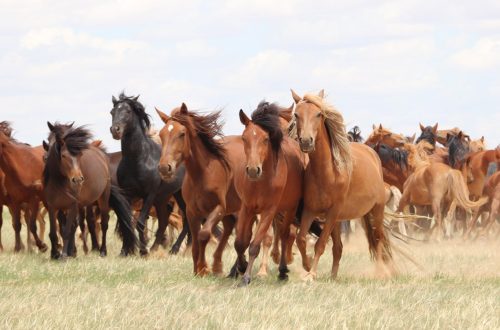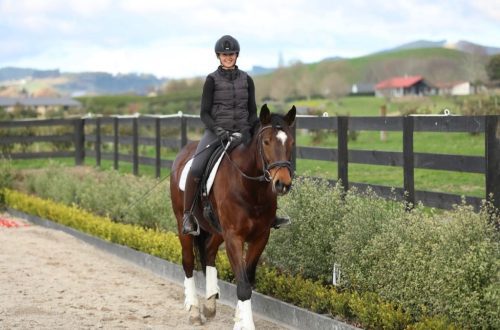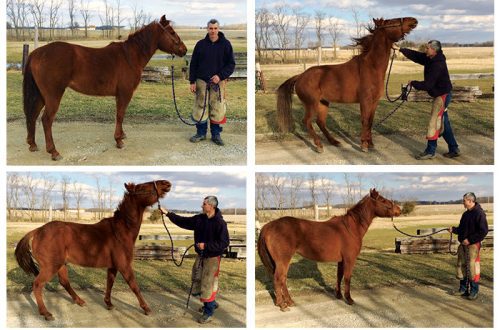
The myth of the lazy horse
The myth of the lazy horse
Over the past century, horses have changed a lot – in general, they have become taller, more advanced and are selected for specific disciplines. The modern tournament horse bears little resemblance to the horses people were familiar with 2000 years ago. Humanity continues to work to create horses that meet its needs, but despite all the efforts of breeders and after generations of domestication, the horse is still a horse, living under the influence of instincts formed thousands of years ago. Specialized breeding has done little to curb the innate natural responses and basic fears of our horse partners, and so training programs and interpretations of horse responses to certain stimuli and signals must be viewed from an evolutionary perspective: what will these behaviors make sense as the horse evolves? What advantage will this horse’s behavior give over other horses, ensuring that a particular characteristic/response will be passed on to future generations?
Equestrians often complain about laziness on the part of the horse. Riders get frustrated that their horses are making them work hard, that they have to use spurs and/or a whip to get the horse to move forward. They become especially annoyed by watching the same “lazy” horse frolic and rush in the levada with his friends, proving that he has a lot of energy.
If we consider laziness from an evolutionary point of view, it is difficult to understand in what way it could give the horse some advantage.. Unlike humans and some other animal species, horses do not bring food to other horses in their group or herd. To survive, they must graze on their own. A horse unable to find its own food and water will soon starve to death. I also note that horses are animals for which the preferred method of survival is flight. A slow or “lazy” horse will be the first animal to be caught and eaten by predators, and therefore laziness is the least likely trait to be passed on to future generations through evolution.
In hotter climates, where breeds such as the Arabian Thoroughbred have developed, predators are solitary hunters in the process of catching their prey. relying on speed and agility. Horses that reacted faster and ran faster had a better chance of surviving to breed and pass on the physical ability to run, as well as the instinctive reaction to the first signs of a predator attack, to their offspring.
In the cooler northern regions, where draft horses and ponies later appeared, predators were slower and more likely to hunt in packs (eg wolves). Horses that reacted to predators with an instant flight quickly got tired of the pursuit of the pack and were caught. With this type of attack, those horses survived that were able to conserve energy, remaining only a step ahead of a predator or other member of the herd. And this trait was needed by the offspring.
Considering all of the above, we must recognize that horses are not inherently and instinctively lazy creatures. Based on this, we should conclude that a lazy horse is doing something from what surrounds it, or we ourselves. It should also be taken into account that laziness can also have a medical reason (malnutrition, anemia or chronic pain). A particular reason to consult a veterinarian is the lethargy of the horse throughout the day, including grazing and feeding.
We are the first consider apparent laziness in representatives of purebred breeds, in Arabian and English Thoroughbred horses. Horses of these breeds are usually very sensitive, impulsive and alert. Often these traits can be unsettling for the rider, who will work to control and subdue the reactions inherent in these breeds.
Training methods often include assistive devices such as dowels, martingales, sharp snaffles, etc. These objects limit the freedom of movement of the horse’s head, keep it in such a position that it is easier to control and keep the horse in submission. Poorly fitting saddles that restrict movement of the horse’s shoulders and back, tense riders who pinch the horse’s shoulders with their knees and strain the horse’s back with their seat, and riders with rough hands can further limit the horse’s ability to move forward freely.
At the same time, the riders use the controls, pushing the horse forward and thus giving conflicting commands.
Some hot horses may react to such restrictions with “unreasonable” panic, becoming prone to running and running. The rider begins to evoke the same primary fear in the horse that the presence of a predator evokes in him.
If the horse is trained in this manner while simultaneously suppressing fear responses, it will soon enter a state of learned helplessness – the same state that a mouse goes into when a cat “plays” with it or a victim that is under constant repetitive attacks – the brain shuts down and shorts out, stops responding, and prevents the subject from dealing with the attack. In the case of a horse, this manifests itself as laziness. The response to the controls is getting boring. The horse walks heavily on the forehand and can often stop, as if in a trance, mindlessly follow the tail of another horse in the arena.
If you sharply delay and send the horse out for seeming laziness, it will most likely react too sharply to your actions – goat, spread, shine. The fact is that the rider will begin to cause reactions in the horse associated with the survival instinct, as well as fear. Feeling trapped, she decides she should run or fight.
In contrast to such horses, there are breeds that descended from the cold-blooded horses of the north – warm-blooded, heavy draft breeds and ponies. These breeds evolved to conserve energy in the presence of a threat. As a rule, representatives of these breeds mature slowly, so they begin to work under the saddle before the onset of physical and mental maturity. Thus, from the very beginning, they can be slow and unmotivated.
Since horses of these breeds are usually not as quick and responsive to controls as hotter horses, forceful methods such as increased whip and spurs are often used to get them to move forward. Horses, by virtue of their characteristics, react quite calmly to this, and riders work harder and harder with their hand and whip in search of the desired return. However, the more pressure or threat this type of horse feels, the more they feel the need to conserve energy (as if they were facing a predator). Riders who are rude and use whips and spurs encourage these horses to slow down and at the same time desensitize them in regards to aid sensitivity. If the rider pushes and pulls the horse at every step, then over time it will begin to consider it “background noise”, while the rider, in turn, will begin to amplify the messages.
Conflicting signals given by riders to coldblooded/warmblood horses can also lead them into a state of learned helplessness. And here it is impossible not to note the fact that it is the “lazy” horses that are especially prone to be afraid of the “horse-eaters” and also to goat and carry. For warm-blooded horses, being scared at the sight of a “horse eater” is the most common way out when the horse is confused and frustrated by the rider’s signals. Over time, such “unreasonable” fears can turn into a chronic habit.
Regardless of its type, A “lazy” horse can be made by constant routine work in the arena and inattention on the part of the rider.
Riders will often “circle” along the walls of the arena, concentrating on working out some nuance in their seat, while the horse begins to get bored at this time. Since the horse doesn’t have the same ability to stay focused on something unimportant as we do, it’s easy to understand that his attention can shift from the rider to something else. If the exercises are repetitive and boring, the horse will no longer enjoy riding and may become a sour, disinterested partner. This situation often results in the rider clamoring for the horse’s attention, “waking” it up, seeking focus (even though there is really nothing for the horse to focus on), resulting in conflicting signals and the problems mentioned above.
For both types of horses troubleshooting mechanism the same. The first thing to look at is the health, well-being, age and fitness of the horse. The trainer should check the horse’s muscles and back, in particular for pain.
Check your ammo very carefully..
When checking saddleslying on a horse, see it when it is in motion. An easy way to do this is to have your helper pull the horse’s front leg forward while you or the trainer check to see if the saddle is blocking the free movement of the shoulder, if the horse is free to raise his back and lower his head (does the saddle interfere with this). movements).
Think about what you are using gland. Does the horse understand its impact? Is it good for her? Different horses have different mouth shapes and different snaffle preferences..
Next consider the age, type and conformation of the horse.
Is it reasonable to require a horse to perform certain movements, considering all these factors? Does his conformation allow, is the horse old enough to perform lengthening strides or pirouettes, collect, etc. Perhaps you are punishing her for not doing what she is physically unable to do? Then you need to rethink your goals for this horse. It is not difficult to understand the feeling that a horse experiences when he is asked to do something that he is not able to do …
Another confusing horse factors that cannot be ignored are gaps in training. You must go back to the basics to make sure the horse understands the most important basic signals: going forward, stopping, yielding backwards and forwards. The horse must also be ready to yield gently to the snaffle when asked to do so from the ground.
If the horse when you ask her to yield to the snaffle, takes a step back, you should probably choose a different snaffle and reconsider basic training.
Remember that even the most insensitive horse can feel a fly on his skin! Your goal should be to awaken the horse’s response to reasonable controls, and not constantly move to more and more strict methods of influence.
I will give examples from my practice.
Case 1: Franz, 6 year old gelding quarter horse
Franz came to me after his owner fell off him a year ago. She was badly injured, and therefore she could not do horse work for a year. Although she didn’t blame Franz for the fall, she felt it was a signal that the horse needed professional help.
Franz’s main problems were the following:
1. He was “lazy” and constantly slowed down or even stopped while riding. It took a lot of effort to get him to go forward and keep the rhythm, especially in the arena.
2. He did not have a stable canter.
3. When he heard the word “whoa” or something like that, he immediately performed a sliding stop, as he was taught this in the past.
Every time I take a horse for training, I first of all evaluate its condition.
I immediately noticed a stiffness in Franz’s neck that needed to be relieved before we could move on. I also appreciated his personality – he was very sociable and wanted to please, but at the same time easily succumbed to excitement if he was taken out of his comfort zone.
When I started riding, I just walked and trotted forward until the horse was in good shape for cantering. Asking a lot from an unprepared horse is the best way to discourage him from working.
I found that Franz was very sensitive to the pressure of the rider’s seat – he stopped as soon as he tightened his lower back and clamped the lock. When I later saw his owner riding him, I understood why she thought he was lazy: her sluice was blocking the horse’s back, to which Franz reacted by stopping immediately. Since Franz was trained by the owner herself, I knew that he had not been trained to demonstrate this reaction. It was more of a natural response from the horse. Since the mistress was a fairly capable rider and understood how to work the lower back and buttocks, I did not retrain Franz – I retrained her.
As Franz prepared to canter, as I rode, I found him doing one or two paces and then stopping, falling heavily on his front. It became obvious that stopping was his response when he was nervous. This made sense for several reasons:
1) In the initial training of a horse, it is usually very praised for stopping, so horses often associate pleasant sensations with stopping. The horse may then try to regain those good feelings when he is nervous and tense during other activities. At the same time, she will stop.
2) Franz would close when he felt pressured and uncertain and his reaction was to stop… other horses can smash, flash or goat at such times.
If I sent him forward with the whip, then most likely he would completely lose confidence and acquire dangerous habits that help get rid of both me and the whip. I base this judgment on the fact that this horse has shown me while working on the ground that he is very eager to please, but is easily agitated and does not respond well to pressure.
The next day, Franz again offered me several canter paces before I ended the session. On the third day, I expected more – I wanted to do a full circle around the arena at a canter. I needed to communicate my intention to the horse without making it feel under undue pressure.
To achieve this, I took a short jumping whip, which I tapped on my thigh to let the horse know that I was waiting for the canter to continue. I used the same sound (tapping) when lunging at a canter, so I was sure that I would be understood correctly. This helped Franz maintain his canter. Since the gallop was a new sensation for him at this point, I asked the horse to go into a trot as soon as I felt that he was beginning to lose rhythm and balance. I wanted to make sure that I was the initiator of the downward transition.
I also worked on an answer to the word “whoa”. When I said “whoa” or asked for it for a reason, he made a sliding stop and lowered his head. It was like stopping a bicycle with a front brake on a downhill. Although riders sometimes take pride in their horse’s ability to stop “on click”, I want the horses I work with to stop by bringing the hindquarters under the body and lightening and lifting the shoulders and forehand. The forehand stop is hard on rider and horse and usually does not help the horse to relax.
To show Franz that I don’t need the usual stops from him, I lightly, by voice command asked him to stop at a trot. When he did a sliding stop, making sure that my hands and seat were not restricting him, I asked him to step forward with a slight push of the legs. Then I praised him with my voice and scratching on the withers and asked him to perform a sliding stop from a walk using my hands and buttocks. I wanted to see the horse come to a halt using his hind legs and letting his front legs take each step to maintain the correct balance. As a result of consistent work, he finally realized that “whoa” does not mean an instantaneous abrupt stop, and began to stop from walk, trot and canter, trying to maintain the right balance. This new understanding of the meaning of “whoa” helped me in teaching Franz the half halts – he began to rebalance himself without getting confused or tense. It also helped him learn to slow down when he was nervous rather than stop abruptly.
Case 2: XNUMX-year-old frieze Walter
Walter came to me for the purpose of further training for dressage. Both the exterior and the movements of the horse were suitable for this. But Walter was a big, heavy gelding. It took a sea of time to transfer him from the stable to the arena – he walked very slowly and often stopped. The ride was the same – he stopped or slowed down with every step for no apparent reason.
Walter was overweight, but he did not experience any pain or stiffness.
When I looked at it more closely during ground practice, I noticed that before I slowed down and stopped, the horse raises its head slightly. Over time, I realized that this was his way of being scared. It would have been easy to drive such a large horse forward with a whip or other similar means, but it would have reinforced his fear of the frightening object. Instead of punishing him for being afraid, I worked on teaching him to lower his head and focus on me. As I walked beside him, I watched his head and neck, and as soon as I saw him begin to raise them, I drew Walter’s attention to me, asking him to lower his head. We were soon able to confidently pass the “terrible” objects without stopping.
Under saddle, Walter was just as slow. There was no momentum in the walk, the trot was slow and tangled. However, the position of his head was pleasant and low, so I didn’t think it was a fear-related reaction.
I noticed that my own reaction was that I constantly pushed him with my legs, and he, after taking a couple of steps forward with acceleration, returned to his slow pace again. Unlike Franz, Walter was not particularly attentive to my landing and generally seemed to be just attuned to my commands.
Because I didn’t want to desensitize Walter to leg or spur pressure, which was done in his early training. I played a game of “do it and forget it” with him.
Day 1. I asked Walter to go off the leg pressure and then rode carefully, trying not to urge him on with my legs. I used my leg to ask for bends and guide, but most of the time my leg just lay along the horse’s body. I made sure my seat and arms moved with Walter and didn’t restrict him. As long as he kept walking, I remained a passive passenger, regardless of the quality of my stride. I tried not to let the horse get bored by making changes in direction and figure. If he tried to stop himself, I thumped with a long dressage whip behind the leg to encourage Walter to move forward. I also slightly changed my position in the saddle. With other horses, I used a short jumping whip more often, but while working with Walter on the ground, I found that he did not respond to a short whip.
Once Walter got the idea of working at the walk, we started to trot. I also didn’t pay attention to its quality, remaining a passive passenger – only using light auxiliary controls to perform figures and changes of direction. This kept the horse interested in the work. If Walter slowed down, moved to a walk or stopped, I lightly tapped the whip behind the leg.
Day 2. Walter, who came out into the arena, seemed to me more energetic – I didn’t have to constantly ask him not to stop. When we switched to a trot, he moved vigorously and again did not need to be corrected.
Day 3. I made the exercise more difficult – now Walter had to support not only gait, but also the pace at which I set it. I was convinced that my claims were justified. So, I asked the horse to slow down and rebalance in front of tight circles and tight corners, allowing him to catch his breath if he stumbled. When I felt that he was slowing down, I first used the leg. If the horse did not answer, then she confirmed the action of the leg with a whip. Because my legs within the last two days mostly calm were lying on his flanks, Walter paid much more attention to my leg thrusts than before, so I had little to no need for a whip. His gaits became more expressive, and his back and neck became more relaxed and lively.
Case 3: Billy is a training horse
Training horses are often called lazy. Many riders complain about them and do not want to take them under the saddle. But every beginner rider must understand that training horses become like this because of the routine work around the circle, because they are constantly kicked at, clinging to their knees to stay in the saddle. These horses deal with conflicting signals from beginners who tend to pull on the reins and kick their sides at the same time. No wonder these horses soon become less responsive and boring. Any fresh and impulsive horse in such work will soon also turn into a dull and lazy one. Adding to the problem is that few of the training horses work under experienced riders who are able to put them in the right frame, so these horses run on the front, with sagging backs, which causes them even more inconvenience and complicates life.
Often, when under the saddle of an experienced rider, the training horse will appear alert and knowledgeable, thus frustrating the novice, who will think that he is a loser.
Billy was used as a training horse for a long time, but finally fell into private hands. His owner wanted the horse to be more responsive and enjoyable to ride.
To help Billy regain his enthusiasm, I first worked on every sore and tight part of his body with a massage, paying particular attention to his topline to help wake up the muscles that would allow him to better carry his rider.
We also worked on the poles and on the cavaletti to get the horse to think about his legs.
For riding, I chose the same exercise that I used with Franz – “Do it and forget it” to make Billy more sensitive to leg pressure. I also tried to avoid working on the wall of the arena – we made smooth loops, small serpentines, ran along the poles and made transitions. This helped keep him interested and focused. My goal was to make sure the horse knew that I was with him, not just because I was in the saddle, but because I gave commands and tips, and also helped him balance. I also worked on lateral movements to develop the necessary for under saddle work. back muscles.
I rode Billy out of the arena and into the field. He had so little experience on such walks that I tried to give him time to get used to the new environment, uneven ground and distance from other horses.
Billy revived, began to show interest in riding under a rider, began to carry himself better. However, later, when a newcomer was put on him, he again turned into a “boring” Billy.
Karen Nelson (source); translation by Valeria Smirnova.





